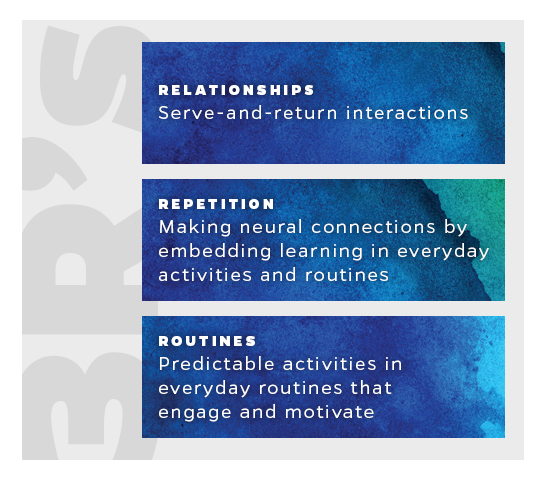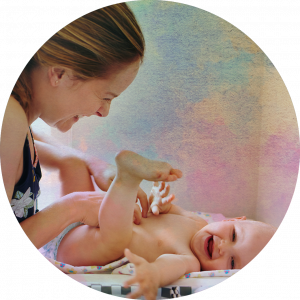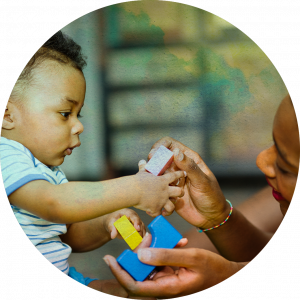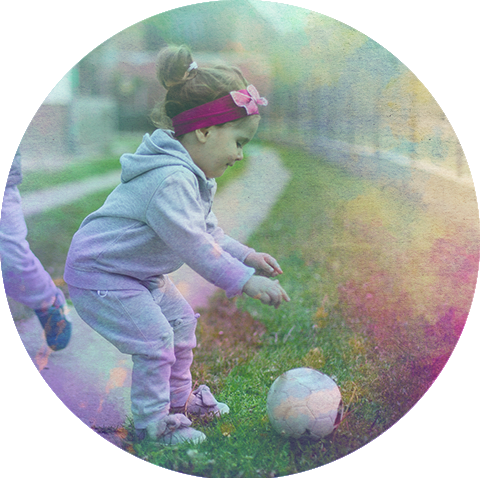A to Z’s of Early Childhood
The Science of Child Development and Learning
E is for Everyday Learning Opportunities
Making the Most of Everyday Routines
Everyday routines at home, in early education and care programs, and in the community offer thousands of opportunities to support children’s early learning and brain development. They also provide natural opportunities for children to learn important skills. Research shows there are strategies adults can use to provide meaningful learning opportunities to children during their everyday routines.
Thinking Beyond Reading, Writing, and Arithmetic: 3R’s of Early Learning: Relationships, Repetition, Routines ™
Many people consider early reading, writing, and arithmetic skills (the traditional 3 R’s) to be the foundation for early learning because they are skills children need to be successful in school and beyond. Though these skills are important, research shows there are three important processes that shape children’s brain development and early learning. We refer to these processes as the new 3R’s of Early Learning: Relationships, Repetition, Routines ™. The new 3R’s of Early Learning are important because they focus on how children learn rather than what they learn.

Supporting Children’s Development and Learning During Everyday Routines
Here are five strategies to make the most out of everyday routines.
Strategy #1 - Think about everyday routines.

Caregiving Routines

Play Routines

Chores and Community Routines
Strategy #2 - Consider what learning opportunities are available in each routine.
Each interaction the child has with others and with things during a routine is a learning opportunity. For example, playing peek-a-boo during diaper changes provides opportunities for a young infant to look and smile at you. Everyday routines like eating meals, playing, and walking to the bus have many opportunities for children to practice language skills. Think about how many times routines happen each day or week and the learning opportunities that are happening within them. It is probably a lot more than you think!




Strategy #3 - Learn about developmental milestones.
Developmental milestones” is a term meaning the age or stage when children first use important skills. For example, when a child walks at around 12 months, we say she or he has reached the developmental milestone for walking. Knowing about developmental milestones and when you see or hear a child do them will help you know which skills the child has learned. It will also help you know what the next skill might be to learn. Opportunities can then be provided for the child to practice and learn skills in everyday routines. To learn more about developmental milestones, visit the Centers for Disease Control and Prevention Developmental Milestones Tracker web page. You can download a free milestone tracker app that can be personalized for each child.
| Example Milestones for Infants (less than 1 year old): |
Example Milestones for Toddlers (1 to 3 years old): |
Example Milestones for Preschoolers (3 to 5 years old): |
|---|---|---|
|
|
|
Strategy #4 - Consider which routines provide opportunities for children to practice skills that are the “next step.”
Download the PDF documents below to learn about Everyday Learning Opportunities with common routines.
DIAPER CHANGES (PDF) MEALS OR SNACKS (PDF)
So Many Ways to Learn!
Look at examples of common routines, what children might be doing in them, and which skills might be good to practice in them to see the many ways children can learn!
Strategy #5 - Create embedded learning opportunities.
Some children might need more practice to learn a skill they use in a routine. You can create planned opportunities for children to practice and learn skills within everyday routines. Sometimes a simple change in the environment or in the routine can provide additional opportunities for a child to practice a skill. When a child does something you are supporting him or her to learn, be sure to provide a positive response. This can be describing what the child did, giving positive attention or affection, or giving the child access to something he or she enjoys or wants.
MAKING THE MOST OF EVERYDAY ROUTINES
Look at these strategies and examples to make the most out of everyday routines!
 |
Example Learning Opportunities for Infants (less than 12 months old): Routine: Diaper change |
 |
Example Learning Opportunities for Toddlers (1 to 3 years old): Routine: Reading a story |
 |
Example Learning Opportunities for Preschoolers (3 to 5 years old): Routine: Play Developmental Milestones: Use 2 to 4 words to ask for an object Learning Opportunity: Roll a ball back and forth a few times. Then hold the ball, look at the child, and wait. If she does not use words to ask for the ball, tell her “Say, ‘I want the ball.’” Child Behavior: The child says, “I want the ball.” Positive Response: Roll the ball back to the child. |
Watch these videos to see specific examples of learning opportunities during everyday routines.
Books and Stories
Outside Play Time
Inside Play
So Many Ways to Learn: Play Time
Diaper Changing and Dressing
Bath Time
Walking
Snack and Meal Time
So Many Ways to Learn: Meal Time
What We Know About Everyday Learning Opportunities
In the first three years of life, more than one million connections or “circuits” are built in children’s brains every second as they interact with adults and other children or with toys or other materials in everyday routines.1
Children’s repeated early experiences and learning opportunities in everyday routines and positive interactions with adults and other children shape how their brains develop. Circuits in the brain that are used more often are maintained. Circuits that are not used or that are not needed are not maintained.1-3
Children learn skills through their repeated experiences interacting with people and the environment.3,4
Young children experience hundreds of different learning opportunities each day at home, in early education and care programs, and in the community.3,5,6
Providing purposeful opportunities for children to practice important skills during everyday routines at home, in early education and care programs, and in the community promotes children’s learning.3,7,8,9
What We are Doing
The Anita Zucker Center and our collaborators are helping families and practitioners learn how to use strategies that will support children’s learning in everyday routines.
Learn more:
- Embedded Instruction for Early Learning (Website)
Watch videos and learn more about our effective and research-based instructional practices for preschoolers with or at risk for learning challenges. - Embedded Instruction for Early Learning-California Project (Website)
Read more about our Tools for Teachers professional development package, which has been shown to increase teachers’ confidence and competence with embedded instruction and promote positive outcomes for children. - Center Members Collaborate with FSU and the Early Steps State Office on Professional Development for Providers (Article)
Read this article about the importance of healthy social-emotional development in early childhood. - Embedded Practices and Intervention with Caregivers (Website)
Learn more about the collaborative EPIC project, an early intervention approach that helps parents and other caregivers provide embedded learning opportunities for infants and toddlers with disabilities during everyday routines and activities.
Other Resources
- Centers for Disease Control and Prevention Developmental Milestones
Visit this website for more information on developmental milestones from 2 months to 5 years old, including milestone checklists and a photo and video library of milestones in action. - Centers for Disease Control and Prevention Milestone Tracker
Download the CDC’s free Milestone Tracker mobile app, where you can track milestones, share summaries, and get tips and activities to support your child’s growth and development. - Three Core Concepts in Early Development (Video)
Watch these videos from Harvard University’s Center on the Developing Child describing important factors in brain development during early childhood. - Vroom Brain-Building Tips
This website offers thousands of fun, free activities you can do with your child during everyday routines to help nurture brain development from birth to age 5. - Home Activity Matrix (.pdf)
Use this tool to share information and plan ways to create opportunities for children to practice targeted skills during everyday routines and activities at home and in the community.
Books and Articles by Center Members and Collaborators
- Snyder, P. A., McLaughlin, T., & Bishop, C. (2018). Maximizing contextually relevant learning opportunities through embedded instruction. In P. A. Snyder & M. L. Hemmeter (Eds.), Instruction: Effective strategies to support engagement, learning, and outcomes: DEC Recommended Practices Monograph Series (No. 4, pp. 51-64). Division for Early Childhood.
- Woods, J., Snyder, P. A., & Salisbury, C. (2018). Embedded practices and intervention with caregivers (EPIC): Linking instruction and family capacity-building recommended practices. In P. A. Snyder & M. L. Hemmeter (Eds.), Instruction: Effective strategies to support engagement, learning, and outcomes: DEC Recommended Practices Monograph Series (No. 4, pp. 145-158). Division for Early Childhood.
- Snyder, P. A., Rakap, S., Hemmeter, M. L., McLaughlin, T. W., Sandall, S., & McLean, M. E. (2015). Naturalistic instructional approaches in early learning: A systematic review. Journal of Early Intervention, 37(1), 69-97. https://doi.org/10.1177/1053815115595461
- Snyder, P., Hemmeter, M. L., McLean, M., Sandall, S., McLaughlin, T., & Algina, J. (2017). Effects of professional development on preschool teachers’ use of embedded instruction practices. Exceptional Children, 84(2), 213-232. https://doi.org/10.1177/0014402917735512
- Salisbury, C., Woods, J., Snyder, P., Moddelmog, K., Mawdsley, H., Romano, M., & Windsor, K. (2017). Caregiver and provider experiences with coaching and embedded intervention. Topics in Early Childhood Special Education, 38(1), 17-29. https://doi.org/10.1177/0271121417708036
References
- Center on the Developing Child. (2007). The science of early childhood development (InBrief). https://developingchild.harvard.edu/resources/inbrief-science-of-ecd/
- National Research Council, & Institute of Medicine. (2000). From neurons to neighborhoods: The science of early childhood development. National Academy Press. https://doi.org/10.17226/9824
- Carta, J., & Snyder, P. (2019). Fifty years of research on children with disabilities and their families: From changing behaviors to transforming lives. In B. H. Wasik & S. L. Odom (Eds.), Celebrating 50 years of child development research: Past, present, and future perspectives (pp. 235-254). Brookes.
- Bronfenbrenner, U. (1992). Ecological systems theory. In R. Vasta (Ed.), Six theories of child development: Revised formulations and current issues (pp. 187-248). Jessica Kingsley Publishers.
- Dunst, C. J., Bruder, M. B., Trivette, C. M., Hamby, D., Raab, M., & McLean, M. (2001). Characteristics and consequences of everyday natural learning opportunities. Topics in Early Childhood Special Education, 21(2), 68-92. https://doi.org/10.1177/027112140102100202
- Dunst, C. J., Hamby, D., Trivette, C. M., Raab, M., & Bruder, M. B. (2000). Everyday family and community life and children’s naturally occurring learning opportunities. Journal of Early Intervention, 23(3), 151-164. https://doi.org/10.1177/10538151000230030501
- Epstein, A. S. (2015). The intentional teacher: Choosing the best strategies for young children’s learning. National Association for the Education of Young Children.
- Division for Early Childhood. (2014). DEC recommended practices in early intervention/early childhood special education 2014. http://www.dec-sped.org/recommendedpractices
- Snyder, P. A., Rakap, S., Hemmeter, M. L., McLaughlin, T. W., Sandall, S., & McLean, M. E. (2015). Naturalistic instructional approaches in early learning: A systematic review. Journal of Early Intervention, 37(1), 69-97. https://doi.org/10.1177/1053815115595461
Receive Additional Support
The complete 3R’s of Early Learning downloadable video recordings (including the A to Z’s of Early Childhood) for use in the field of childhood development to facilitate learning are available for purchase.
If you would like to purchase these resources or speak with a member of our team for help in providing professional development, please complete this contact form.

